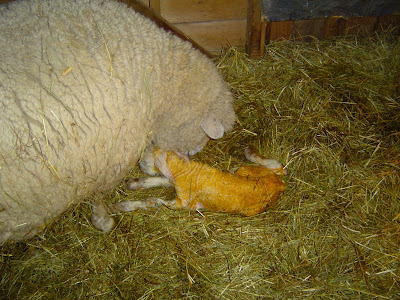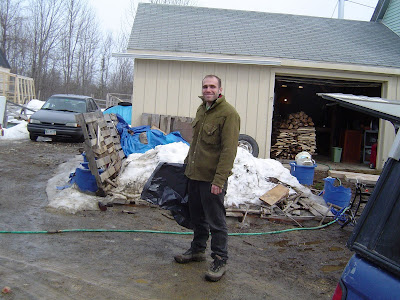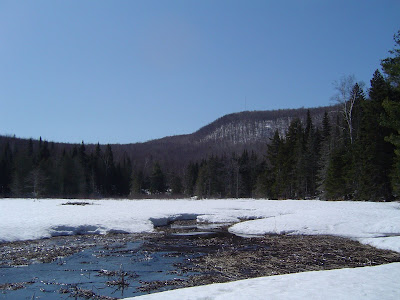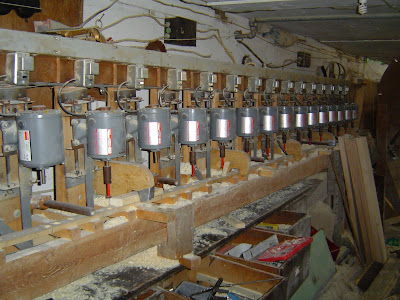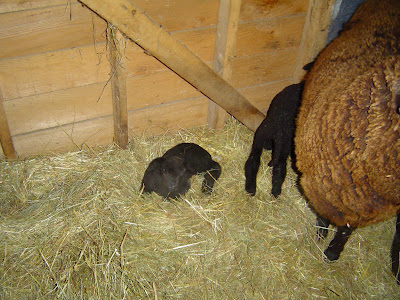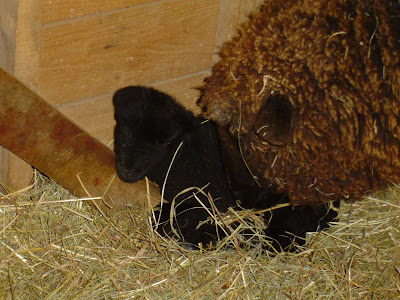

The Womerlippi Farm has been a hive of activity lately, although the humans were not the active ones, at least not on the farm. Since Tillie dropped her two white lambs last week, Nellie dropped one, her first "starter" lamb, pictured above, which she seems very proud and attentive of. This baby comprises the first lamb born to a ewe that was also born and raised on this farm.
Well done, Nellie!
She's a good mother although like a lot of new ewes, seemed to take forever to let the lamb feed. Every time the little bugger would head for the teat, Nellie would back away as if to say, "Hey! What do you think you're doing?" The other three-yearling mother we've had, Molly, did exactly the same last year.
There's a procedure for dealing with this, manual placement of the lamb on the teat. Twice we held her down and placed the lamb onto the teat manually, just to make sure he wouldn't weaken. Each time he drank very greedily.
But eventually she got the idea, allowed the baby to feed, and the little bugger is now strong enough to join the rest of the flock later today.
That was quite a bit of activity and excitement for everyone in the barn, and things had just settled down again, when I went out this morning to find Molly licking a new black lamb. She hadn't been separated yet, no particular signs being shown, except for a moment yesterday when she wandered off on her own unusually.
That meant that all the other sheep and lambs in the main pen were bleating away an emergency alert at 5 am when I stumbled groggily into the barn to see what was up. So I got the others our of the way by opening the back door, shooing them out, and closing it behind them. Then I picked up the newborn black lamb, bleating lustily, and put it in the second lambing pen (the first still occupied by Nellie), and then proceeded to push and pull Nellie in that direction. She's a big four-year old ewe, at the height of her conditioning, and this was a bit like Shaun the Sheep pushing massive Shirley on the kids' TV program, except that Molly fought back.
It was after I got her separated that I realized that a second white lamb still bleating away by the hay rack was not in fact one of Tillie's twins left behind when mom was shooed out, but a white lamb new-born to Molly.
These three latest, Nellie's one and Molly's two, are the offspring of Snorri, the rental ram from last fall, also pictured.
Snorri, who came in a pick-em-up truck from the Beach family farm west of Farmington, Maine, is a crossbred Corriedale/Romney ram like ours, but shorter, fatter, heavier in the head and face, and with more facial fleece.
He's a very cute and gentle ram which we liked a lot. Were we not bound by a promise to the previous, rather unpractical owners of this flock to keep our current stud until some natural death, that might have been the end for himself, Abraram, who is mean and somewhat dangerous and has rather more daughters around than my geneticist wife is comfortable with. Bringing Snorri in for a season was a good compromise. We have multiple quite well-separated pens, so Snorri was able to be secluded well away from Abe with all Abe's duaghters, and now we reap the benefits of this deal, which cost us about 25 pounds of lamb and ham in trade, but was well worth it since we now have three lambs we would not otherwise have been able to breed.
There might be one or two more depending on how well Snorri got on with our slightly retarded ewe, Lark.
Lark, or Larkie, had white muscle disease as a baby, although not on our farm where we take the proper precautions. As a result, she was a late bloomer and a runt, and only filled out to adult size in her fourth year. Now a very late developing five-year old, she still is the filthiest sheep we know, lacking the intelligence to keep her coat clean or even stay out of the muck. We put her in with Snorri more in order to have a place to put her away from her incestuously minded father than to actually breed her. Again,we are bound by this promise not to cull her, nor any of the flock we started with three years ago, although we really should have done so.
But increasingly I think I see a bulge in her side.
I hope she is bright enough to be a decent mother. I guess we may find out.
